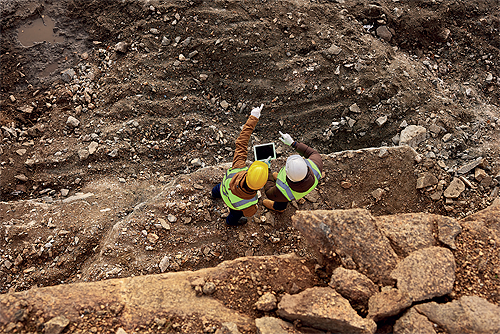A firm foundation
AS IOT AND AUTOMATION PROLIFERATE IN MINING, MANAGED CONNECTIVITY BECOMES CRITICAL TO OPERATIONS. BY JAMES TREVELYAN
Automation in the mining industry is on a roll. The market for automation technology and equipment is growing at seven per cent a year and is forecast to reach $6.2 billion in sales by 2025, according to Grand View Research. Digital transformation is creeping into everything from trucks, drills and trains to back-office functions like procurement and supply chain logistics.
It is no wonder. Mining revenues are driven by global commodity markets, so lowering costs and improving efficiency is the only effective way to shore up the bottom line. Health and safety run a close second to cost and efficiency gains as a reason for adopting the Internet of Things. That is why the biggest mining companies are now splashing out on automated drill rigs, robots, drones, autonomous vehicles and driverless trains.
Shaky foundation?
Like other industries, mining companies are finding that the same investments that strengthen their operations can create new vulnerabilities. The more digital systems at work onsite, the more critical secure and reliable communications become. Without a well-thought-out communications architecture, the automation house is built on sand.
Call it the Connected Mine. That is shorthand for a bundle of individual solutions that do more than automate a process and make each operation part of a comprehensive management platform and ensure that each mine has access to the information and services needed to support and protect onsite managers, workers and assets.
A comprehensive architecture for the Connected Mine includes these elements:
Onsite Connectivity. Wireless communications by private LTE, Wi-Fi and mesh radio networks connecting people and devices.
- Backhaul Connectivity. Depending on the mine’s location, a mix of satellite, LTE, microwave and optical fiber provide robust connectivity to regional or head offices and the public switched network.
- Autonomous Loaders, Trucks and Drills. Autonomous technology is handling repetitive operations at lower cost while improving safety. Vehicles navigate using signals from wireless beacons that provide accuracy to the centimeter.

- Asset Trackers. Hundreds of millions of dollars of equipment are at risk at major mines. Asset tracking technology can show the location of equipment and automatically trigger alerts whenever it leaves its assigned location.
- Sensors and Actuators. IoT applications gather data from sensors throughout the mine for real-time analysis at a central control center, which can remotely activate equipment in response, either manually or automatically.
- Video Cameras. More than mere surveillance, video analytics can automatically identify and flag human errors that may endanger people and operations, from missing hard-hats to unsafe handling of explosives.
- Automation Platforms. From sensor and video data, mining operators can deploy dashboards that display the health of the entire mining site, trigger alerts and notifications and permit operators, both onsite and remote, to drill down to identify the source of problems.
Keeping the data flowing
Realizing the connected mine takes more than technology. It involves a fundamental shift in connectivity. To achieve breakthroughs in safety, productivity and profitability, data must flow at high volume with no interruptions or degradation of service.
Because mines operate in remote locations, delivering that connectivity requires the integration of multiple communication technologies into a high-performance whole. Many companies may be involved, but there needs to be a single point of accountability. Key elements in connectivity for the connected mine include:
- Multi-mode terminals that support multiple satellite bands, microwave links and cellular service, and interconnect seamlessly with local wired and wireless (Wi-Fi, private LTE, LORA) networks. Terminal software manages the logistics of making and breaking connections, from virtual SIM cards to least-cost routing.
- A dedicated global network of satellites, teleports, fiber and high-performance cellular base stations in strategic locations, plus high-capacity peering with wired and mobile networks, to ensure connectivity from remote locations to the rest of the world.
- Intelligence in the network that identifies available transmission routes and automatically switches service between them to achieve the best performance at lowest cost. At the highest levels, using technologies like SD-WAN, it automatically analyzes and manages traffic among routes offering very different kinds of performance, providing customers with predictable quality of service and better utilization of available bandwidth.
Advances in performance and price have given mine operators cost-effective connectivity options that can make the connected mine of the future a good business proposition today. Getting those options to deliver value in the field, however, requires a depth of technical knowledge and experience with the logistical and regulatory challenges of global communications.
The future of the Connected Mine
Mining will continue to be a cyclical business subject to surges and declines in commodity prices, as well as being a challenging way of life for miners and managers alike. The digital revolution is making mining operations safer, more predictable and more responsive to changes in markets. That is attracting a new generation of innovators ready to build a stronger industry for the future.
SPEEDCAST INTERNATIONAL LTD
James Trevelyan is Senior Vice President of Global Sales at Speedcast International Ltd, the world’s most trusted communications and IT services provider, delivering critical communications solutions to the Maritime, Energy, Mining, Media, Telecom, Cruise, NGO, Government, and Enterprise sectors. With more satellite capacity than any other provider, Speedcast enables faster, seamless pole-to-pole coverage from a global hybrid satellite, fiber, cellular, microwave, MPLS and IP transport network with direct access to public cloud platforms.
For further information please visit: www.speedcast.com
